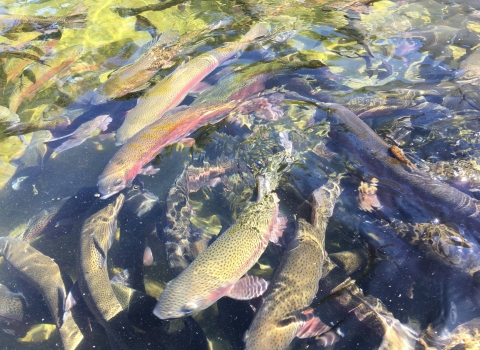The RCDP is an addendum to the Services previously released Natural Resource Damage Assessment Plan. Trustees want to hear from anyone who may be interested in this issue, since this is a public process for public natural resources. They also hope that the RCDP will help the public understand how natural resource restoration projects can be selected using federal regulations, and in conjunction with cleanup decisions made under Superfund and State/Company agreements. Since the process is complicated and natural resource damage assessment plays a central role in decisions for the Fox River and Green Bay, the Service hopes that the public will read and comment on the RCDP, before the October 21 deadline.
Trustees include: the U.S. Fish and Wildlife Service, the Menominee Indian Tribe of Wisconsin, the Oneida Tribe of Indians of Wisconsin, and the National Oceanic and Atmospheric Administration.
This RCDP is the second addendum to the August 1996 Assessment Plan and explains how natural resource damages will be calculated using restoration planning, economic valuation, and direct coordination with the U.S. Environmental Protection Agency and Wisconsin Department of Natural Resources.
The RCDP:
Shows how Natural Resource Damage Assessment and cleanup of the Fox River through such programs as Superfund and State/Company agreements relate. Cleanup under those programs focuses on making the environment safe, while Natural Resource Damage Assessment focuses on returning the environment to its condition before PCB exposure.
Explains the relationship between restoration planning and compensation for losses by the public. The trustees use restoration planning to determine how best to repair the environment to a condition as if PCBs had never been released from paper mills. Additionally, trustees determine what else can be done to improve the environment to make up for continuing PCB problems, until the environment is repaired. Projects can include stopping the spread of PCBs, controlling other pollution problems such as agricultural runoff, enhancing or protecting habitat, and educating the public regarding natural resources.
Describes the types of projects that can be done and how the trustees feel various projects can be compared fairly. Economic studies help trustees determine how the public values the projects and what needs to be done to make up for PCB problems.
Details how trustees will use economic studies and other criteria to determine what can and should be done.
Explains how trustees are coordinating efforts with EPA and the DNR, and how cleanup decisions relate to restoration decisions.
David Allen, Natural Resource Damage Assessment Specialist in the Services Green Bay field office, noted, A faster, more complete cleanup can greatly reduce the amount of additional work needed to completely repair the environment, or make up for lingering PCB problems during and after cleanup. By working together, the trustees, EPA and DNR can better study the site, make decisions, negotiate with the paper mills, and help the environment.
Requests for copies of the RCDP can be mailed to:
Frank Horvath
U.S. Fish and Wildlife Service
Region 3 (attn: ES/EC-NRDA)
BHW Federal Building
1 Federal Drive
Fort Snelling, MN 55111-4056
The U.S. Fish and Wildlife Service is the principal Federal agency responsible for conserving, protecting and enhancing fish, wildlife and plants and their habitats for the continuing benefit of the American people. The Service manages the 93-million-acre National Wildlife Refuge System which encompasses more than 530 national wildlife refuges, thousands of small wetlands and other special management areas. It also operates 66 national fish hatcheries, 64 fishery resource offices and 78 ecological services field stations. The agency enforces Federal wildlife laws, administers the Endangered Species Act, manages migratory bird populations, restores nationally significant fisheries, conserves and restores wildlife habitat such as wetlands, and helps foreign governments with their conservation efforts. It also oversees the Federal Aid program that distributes hundreds of millions of dollars in excise taxes on fishing and hunting equipment to state fish and wildlife agencies. For further information about the programs and activities of the U.S. Fish and Wildlife Service in the Great Lakes-Big Rivers Region, please visit our home page at: http://midwest.fws.gov


